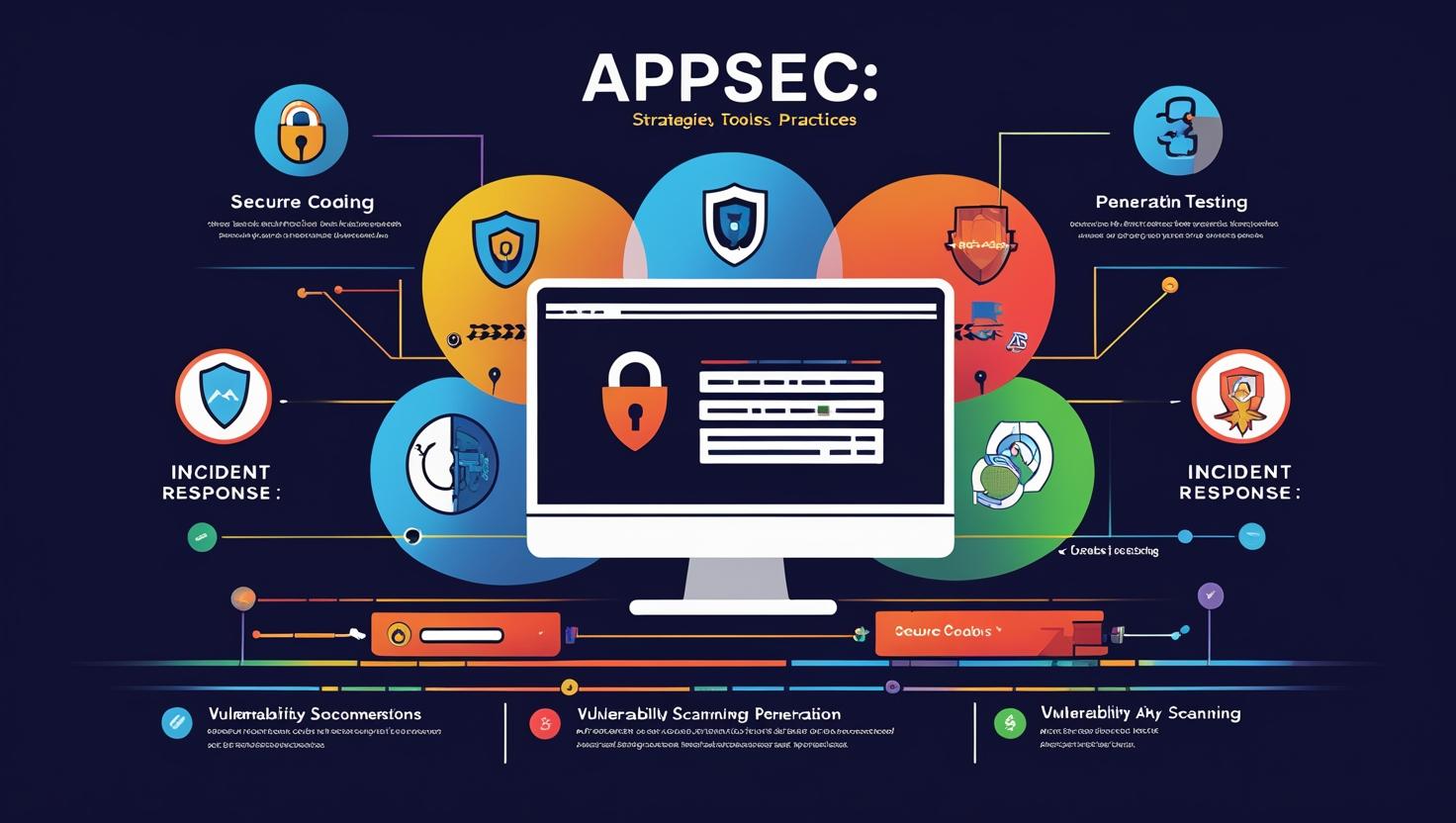In today’s digital-first world, software powers everything — from financial transactions to hospital records. But with great code comes great responsibility. As organizations deploy more applications, the threat landscape grows wider, and vulnerabilities become more costly. That’s where AppSec, short for Application Security, steps in.
Whether you’re a developer, security analyst, or IT manager, understanding AppSec is crucial for safeguarding your apps and protecting user data. This comprehensive guide dives into what AppSec is, the key strategies to secure your applications, and the essential tools you can use — complete with real-world examples.
What is AppSec?
Application Security (AppSec) refers to the process of making applications more secure by finding, fixing, and preventing security vulnerabilities throughout the software development lifecycle (SDLC). It involves integrating security practices and tools into every phase of development — from planning and coding to testing and deployment.
Traditionally, security was treated as a final step before release, but in the age of Agile and DevOps, “shift-left security” — addressing security earlier in the SDLC — is now the gold standard.
Why AppSec Matters
- Data Breaches Are Expensive: According to IBM, the average data breach cost reached $4.45 million in 2023.
- Compliance Regulations: Failing to secure applications may lead to violations of laws like GDPR, HIPAA, or PCI-DSS.
- Business Reputation: A single vulnerability can damage user trust and brand value.
The stakes are high. That’s why AppSec isn’t just a developer issue — it’s a business imperative.
Key Strategies for Application Security
Let’s break down some of the most effective strategies you can apply to strengthen AppSec:
1. Secure Software Development Lifecycle (SSDLC)
Secure development begins with integrating security checks and protocols at each SDLC stage. This includes:
- Threat modeling during the design phase
- Secure coding practices during development
- Security testing during QA
- Runtime monitoring during deployment
Example: A fintech company using SSDLC may use threat modeling tools like Microsoft Threat Modeling Tool to anticipate threats like SQL injection or session hijacking during design.
2. Threat Modeling
Before writing a single line of code, developers should understand how attackers might exploit their app. Threat modeling identifies potential vulnerabilities and misconfigurations.
Popular threat modeling frameworks include:
- STRIDE (Spoofing, Tampering, Repudiation, Information disclosure, Denial of service, Elevation of privilege)
- DREAD (Damage, Reproducibility, Exploitability, Affected users, Discoverability)
Example: When building a login module, threat modeling helps identify threats like brute-force attacks or improper session management.
3. Secure Coding Practices
Preventing vulnerabilities starts with developers writing secure code. Following secure coding standards — such as those from OWASP and CERT — reduces the risk of common issues like:
- SQL Injection
- Cross-Site Scripting (XSS)
- Cross-Site Request Forgery (CSRF)
- Broken Authentication
Example: Use prepared statements instead of string concatenation in SQL queries to prevent SQL injection.
# Insecure
query = "SELECT * FROM users WHERE username = '" + user_input + "'"
# Secure
cursor.execute("SELECT * FROM users WHERE username = %s", (user_input,))
4. Static Application Security Testing (SAST)
SAST tools analyze your source code or bytecode before the application runs. They find bugs early in the development process.
Popular SAST tools:
- SonarQube
- Checkmarx
- Fortify Static Code Analyzer
Example: A developer pushes code to GitHub, triggering a CI/CD pipeline that uses SonarQube to scan for security flaws like hardcoded passwords or unvalidated inputs.
5. Dynamic Application Security Testing (DAST)
DAST tools test your application in a running state, simulating external attacks. They’re ideal for finding runtime issues such as XSS, insecure cookies, and more.
Popular DAST tools:
- OWASP ZAP
- Burp Suite
- Acunetix
Example: Before deploying a new web app, a security team uses OWASP ZAP to scan endpoints and detect vulnerabilities like open redirects or cookie misconfigurations.
6. Software Composition Analysis (SCA)
Modern applications often rely on open-source components. SCA tools analyze your software stack to identify known vulnerabilities in third-party libraries.
Popular SCA tools:
- Snyk
- WhiteSource (now Mend)
- Dependabot
Example: If your app uses a vulnerable version of Log4j, Snyk alerts you and suggests a safer version.
7. Interactive Application Security Testing (IAST)
IAST tools work inside the application during runtime, providing real-time analysis by watching how the code behaves under test conditions.
Popular IAST tools:
- Contrast Security
- Seeker by Synopsys
Example: During QA, IAST tools can detect issues like unvalidated redirects by observing how user input flows through the system.
8. Runtime Application Self-Protection (RASP)
RASP tools are embedded within the application and provide real-time threat detection and prevention during production use.
Popular RASP tools:
- Imperva RASP
- Signal Sciences
- Contrast Protect
Example: If an attacker tries a SQL injection during login, RASP detects the anomaly and blocks the request instantly.
Tools and Platforms You Should Know
Below is a categorized list of essential AppSec tools, with examples of how to integrate them into your workflow:
| Category | Tools | Integration Example |
|---|---|---|
| SAST | SonarQube, Fortify | GitHub Action runs SAST on every pull request |
| DAST | OWASP ZAP, Burp Suite | Scheduled scans of staging environment |
| SCA | Snyk, Dependabot | Alerts when a vulnerable package is introduced |
| IAST | Contrast, Seeker | Tests instrumented apps in QA environments |
| RASP | Imperva, Signal Sciences | Blocks malicious runtime behavior in production |
AppSec in DevOps and CI/CD Pipelines
AppSec isn’t a roadblock to DevOps — it’s a vital part of it. Security tools should plug directly into your CI/CD pipelines to provide fast feedback to developers.
Example CI/CD Security Flow:
- Commit Code: Developer pushes code to Git.
- SAST Scan: Code is scanned by SonarQube.
- SCA Check: Snyk checks dependencies.
- DAST Scan: ZAP scans the deployed staging app.
- Approval Gate: Deployment proceeds only if critical issues are resolved.
This enables rapid, secure development — a core goal of DevSecOps.
Best Practices for Effective AppSec
🔐 1. Train Developers
Security isn’t just a tooling issue. Educate your developers on secure coding via platforms like:
- Secure Code Warrior
- OWASP Juice Shop (for hands-on practice)
🧩 2. Use the OWASP Top 10
The OWASP Top 10 is a must-read for any AppSec program. It outlines the most critical web application risks, including:
- Injection
- Broken Authentication
- Insecure Design
- Security Misconfiguration
📊 3. Continuous Monitoring
Use monitoring tools like Wazuh, Elastic SIEM, or Microsoft Defender for Cloud Apps to observe anomalous behavior post-deployment.
🧪 4. Penetration Testing
Conduct regular pen tests using tools like Kali Linux, Metasploit, or hire third-party red teams to simulate real attacks.
🔁 5. Update and Patch Frequently
Unpatched applications are an attacker’s dream. Use automated tools to track software versions and deploy patches in your CI/CD process.
Sample AppSec Workflow with Tools
Imagine you’re building an e-commerce platform:
- Planning: Perform threat modeling using Microsoft’s Threat Modeling Tool.
- Development: Enforce secure coding with ESLint + security plugins.
- SAST + SCA: GitHub Actions run SonarQube and Snyk on every commit.
- Build: Jenkins pipeline builds Docker containers.
- DAST: OWASP ZAP scans staging site after deployment.
- Production: RASP defends against real-time attacks.
By integrating these practices, you create a resilient software environment that resists threats while maintaining development velocity.
Final Thoughts
AppSec is no longer optional — it’s an integral part of responsible software development. In a world where software drives business and attackers get more sophisticated by the day, ignoring AppSec is like driving blindfolded.
By adopting proactive strategies, integrating security tools into your DevOps pipelines, and fostering a culture of secure coding, you can build applications that are not only functional but fortified.
Want to dive deeper into cybersecurity roles? Check out our detailed SOC Analyst course to understand how AppSec fits into a broader blue-team strategy.

